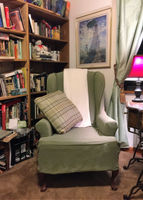In my first iteration as a college student, I had trouble choosing between English and Theatre as a major. (We theatre geeks spell the subject with the British “re” instead of “er”. It shows our snobbish devotion to British plays.) During every semester, almost every week, I’d wrestle with the issue: was my primary devotion to the stage or to books? It turns out I lack the temperament necessary for a theatrical life. I like regular hours, daylight, and sleeping at home instead of a green room. What I do like is reading plays.

In their dormant form, plays look the like every other book; reading them takes a slightly different set of skills. With the publication of Rowling/Tiffany/Thorne play,
Harry Potter and the Cursed Child, those differences have become apparent to a wider audience. Just remember, novels and plays are different ways of seeing a story.
In a novel, the author controls the story world and lyrically shows the reader what he/she needs to see. The description may be confined to a few, sparse details (like Hemmingway’s) or may roll into long, lush paragraphs. These parts are where the narrator’s voice soars before dropping back to the dialogue of the book. Dialogue is dynamic device but only one part of the story.
Smash cut to reading plays where Dialogue is King. Dialogue is the structure everything in the play hangs on, from the first moment to final curtain. (The only exceptions are musicals since music halves that work with the words.) When dialogue is well-written, you can hear it in your brain, pauses and all, as if an actor was already speaking it. There is no narrative voice. It’s the job of the actors and crew to create the atmosphere a novelist outlines with that voice and their only aids are the dialogue and a few stage directions.
Stage directions can throw novice readers of plays because they look a little like description. But instead of filling out your perspective of the story while moving the plot slowly along, these are directives from the playwright to the cast and crew, not written for a reader’s enjoyment. Look at Platform 9 3/4 as an example.
Rowling takes more than a page in Sorcerer’s Stone to describe the famous railway platform and, like Diagon Alley, it’s an overwhelming site for the senses. Smoke is billowing from the engine to the platform, owls are hooting, cats are everywhere, large trunks are stacked up in piles and the entire place is covered in wizards. Young ones are already on the train, waving from the windows to their families. Families or friends make up knots of people on the platform, and everyone is chattering in a hundred different conversations. Now compare all that with the stage direction for the same place:
Which is covered in thick white steam pouring from the HOGWARTS EXPRESS. And which is also busy – but instead of people in sharp suits going about their day – it’s wizards and witches in robes mostly trying to work out how to say good-bye to their beloved progeny.
Harry Potter & the Cursed Child, Act One, Scene Two
The novel’s description sounds like a tour, the play’s stage direction tells the stage manager what the set needs to look like and the actors how to play the scene. By the way, stage directions have become more detailed through the years. Shakespeare’s directions are limited to things like, “King Enters”; “Queen Exits”; “They fight” and “Hamlet dies.” The modern and contemporary playwrights sometimes write stage directions with extensive detail but the purpose of both is the same: to get the actors to perform the piece as the playwright envisions it. Directions aren’t printed to entertain the audience; they’re there to instruct the players.
This doesn’t mean reading plays isn’t fun. Plays can be wonderful things to read and, I must admit, the climax of HP & the Cursed Child evoked a visceral reaction from me, just like JKR’s series did years ago. The story keeps her great themes of love and sacrifice, and it doesn’t shy away from what scares you. Instead, it uncovers what frightens you most, and lets it stride free into the audience. That’s more immediacy than I might be able to handle.
So, if you want, take a crack at a play. Choose a good one, if this is the first play you’ve read. It will be a slightly different journey than reading a book but both vehicles try to tell you a story. The difference is perspective. When you read a novel, you get just a touch of emotional distance since you see it from the author’s eye-view. When you watch a movie, you see it from your seat. When you read a play, you’re part of the performance; a performance acted out in your head.
 In their dormant form, plays look the like every other book; reading them takes a slightly different set of skills. With the publication of Rowling/Tiffany/Thorne play, Harry Potter and the Cursed Child, those differences have become apparent to a wider audience. Just remember, novels and plays are different ways of seeing a story.
In their dormant form, plays look the like every other book; reading them takes a slightly different set of skills. With the publication of Rowling/Tiffany/Thorne play, Harry Potter and the Cursed Child, those differences have become apparent to a wider audience. Just remember, novels and plays are different ways of seeing a story.

No Comments
Comments are closed.